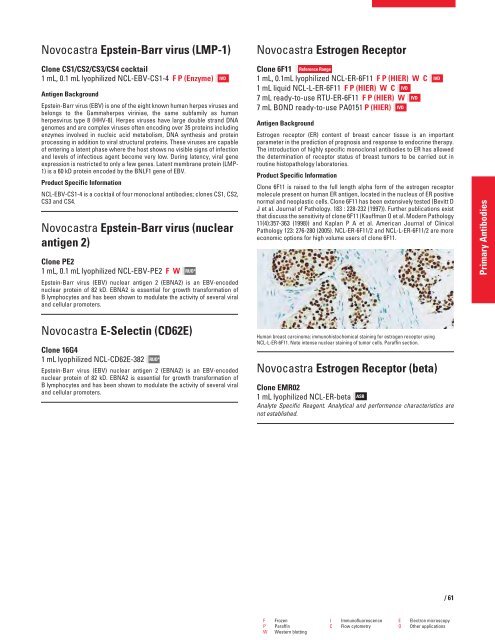QF0159 Marketing Release Record
QF0159 Marketing Release Record
QF0159 Marketing Release Record
You also want an ePaper? Increase the reach of your titles
YUMPU automatically turns print PDFs into web optimized ePapers that Google loves.
Novocastra Epstein-Barr virus (LMP-1)<br />
Clone CS1/CS2/CS3/CS4 cocktail<br />
1 mL, 0.1 mL lyophilized NCL-EBV-CS1-4 F P (Enzyme)<br />
Antigen Background<br />
Epstein-Barr virus (EBV) is one of the eight known human herpes viruses and<br />
belongs to the Gammaherpes viriniae, the same subfamily as human<br />
herpesvirus type 8 (HHV-8). Herpes viruses have large double strand DNA<br />
genomes and are complex viruses often encoding over 35 proteins including<br />
enzymes involved in nucleic acid metabolism, DNA synthesis and protein<br />
processing in addition to viral structural proteins. These viruses are capable<br />
of entering a latent phase where the host shows no visible signs of infection<br />
and levels of infectious agent become very low. During latency, viral gene<br />
expression is restricted to only a few genes. Latent membrane protein (LMP-<br />
1) is a 60 kD protein encoded by the BNLF1 gene of EBV.<br />
Product Specific Information<br />
NCL-EBV-CS1-4 is a cocktail of four monoclonal antibodies; clones CS1, CS2,<br />
CS3 and CS4.<br />
Novocastra Epstein-Barr virus (nuclear<br />
antigen 2)<br />
Clone PE2<br />
1 mL, 0.1 mL lyophilized NCL-EBV-PE2 FW<br />
Epstein-Barr virus (EBV) nuclear antigen 2 (EBNA2) is an EBV-encoded<br />
nuclear protein of 82 kD. EBNA2 is essential for growth transformation of<br />
B lymphocytes and has been shown to modulate the activity of several viral<br />
and cellular promoters.<br />
Novocastra E-Selectin (CD62E)<br />
RUO*<br />
Clone 16G4<br />
1 mL lyophilized NCL-CD62E-382 RUO*<br />
Epstein-Barr virus (EBV) nuclear antigen 2 (EBNA2) is an EBV-encoded<br />
nuclear protein of 82 kD. EBNA2 is essential for growth transformation of<br />
B lymphocytes and has been shown to modulate the activity of several viral<br />
and cellular promoters.<br />
IVD<br />
Novocastra Estrogen Receptor<br />
Clone 6F11 Reference Range<br />
1 mL, 0.1mL lyophilized NCL-ER-6F11 F P (HIER) W C<br />
1 mL liquid NCL-L-ER-6F11 F P (HIER) W C IVD<br />
7 mL ready-to-use RTU-ER-6F11 F P (HIER) W IVD<br />
7 mL BOND ready-to-use PA0151 P (HIER) IVD<br />
Antigen Background<br />
Estrogen receptor (ER) content of breast cancer tissue is an important<br />
parameter in the prediction of prognosis and response to endocrine therapy.<br />
The introduction of highly specific monoclonal antibodies to ER has allowed<br />
the determination of receptor status of breast tumors to be carried out in<br />
routine histopathology laboratories.<br />
Product Specific Information<br />
Clone 6F11 is raised to the full length alpha form of the estrogen receptor<br />
molecule present on human ER antigen, located in the nucleus of ER positive<br />
normal and neoplastic cells. Clone 6F11 has been extensively tested (Bevitt D<br />
J et al. Journal of Pathology. 183 : 228-232 (1997)). Further publications exist<br />
that discuss the sensitivity of clone 6F11 (Kauffman O et al. Modern Pathology<br />
11(4):357-363 (1998)) and Kaplan P A et al. American Journal of Clinical<br />
Pathology 123: 276-280 (2005). NCL-ER-6F11/2 and NCL-L-ER-6F11/2 are more<br />
economic options for high volume users of clone 6F11.<br />
Human breast carcinoma: immunohistochemical staining for estrogen receptor using<br />
NCL-L-ER-6F11. Note intense nuclear staining of tumor cells. Paraffin section.<br />
Novocastra Estrogen Receptor (beta)<br />
Clone EMR02<br />
1 mL lyophilized NCL-ER-beta ASR<br />
Analyte Specific Reagent. Analytical and performance characteristics are<br />
not established.<br />
F Frozen I Immunofluorescence E Electron microscopy<br />
P Paraffin C Flow cytometry O Other applications<br />
W Western blotting<br />
IVD<br />
/61<br />
Primary Antibodies
















